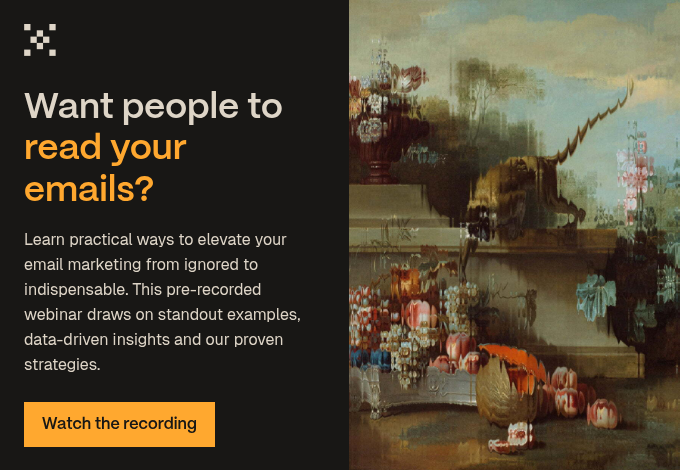Marketing is the visible tip of the change management iceberg. With every new marketing initiative, engagement or campaign there lies - underneath it all - the need to manage change.
As a business owner, change management is something I often have to navigate, too. That's certainly been the theme of the last year for Articulate Marketing. So, like all the best Ted Talks, I'll start by taking you back in time. Back... to last summer...
(This article is based on my webinar, which you can view here on my personal website, GeekBoss.)
Articulate's year (and a half) of change
Like many businesses during 2020, we were under stress. Working too hard. Growth was stalled. Profitability was declining. All this coupled with anxieties about the impact of the pandemic.
We needed to change.
Realising this, in itself, was a big moment. After months of soul searching, consultation and data-gathering, we had a cards-on-the-table discussion with everyone in the business. Here, I set out to implement a sweeping set of changes that would, hopefully, set us on a new path.
In order to do so - and this is my first recommendation to you - we decided to make space for change. It's vital to start any change management project with space. Clear the decks. Stop other activities or projects. This leaves room for thinking, reflection and discussion. And when the time comes, for the work of change itself.
We then embarked on a mission to change all our tools and processes, project management processes, how we manage clients, how we did sales and even how we ran the business. We moved from individual leadership to a collective management team. It was ambitious, but necessary.
Along the way, we learned two major lessons:
Lesson 1 - Change is hard
I realised, if we were to progress, I simply couldn't be the valve through which everything flowed. That was a bit of a shock. As a business owner, I think this change management project was the hardest thing I have ever done. And I've done a lot in my life!
One reason business change can be so difficult is that CEOs, like me, think change happens like this: all heroic leadership and the troops instantly fall in line behind you.
In reality, most change projects are quite chaotic. For the people to whom change happens, it can be very stressful, confusing and complicated. This is the psychological gap that has to be closed.
In fact, Elrod and Tippett (2002), suggest that organisational change causes employees to experience phases of the grief process identified by Kübler-Ross: shock, denial, frustration, depression, experiment, decision, integration.
A lot of things that employees thought they knew, and the status or power that they had acquired by knowing what they were doing, gets undermined. People seek stability and familiarity, so change can actually trigger grief.
Some people move through this process very quickly. Other do not - likely because the circumstances of each individual's relationship to the change that's happening is different. Some people might be very severely affected. For example, if a change makes their job redundant. Happily, that didn't happen for us.
As the boss, you get to anticipate change. You're in control and, of course, you don't have to communicate it with yourself. To take an analogy from my life: when I was a pilot, I never felt air sick. But when somebody else was flying the plane, I often felt quite nauseous. Being in control makes change easier to tolerate.
Lesson 2 - Change can lead to failure (and that's OK)
Beware inertia: the failure point where you give up, lose momentum, fail to provide enough energy to change the state of the business. It could be there's not enough incentive or consensus for the change. Maybe you're trying to change the wrong things in the wrong ways. Maybe there is no silver bullet. Maybe 'good enough' isn't actually good enough.
There are lots of ways change can fail. It's a leader's job to map out that landscape and figure out where the failures might lie. But, remember that sometimes it doesn't work out. You might have to change again, refactor, cut your losses.
How to communicate change
'The posture of leadership is calm presence', somebody once said. You don't want to sound like you are scared or uncertain, or the business is at risk. There's a lot of pressure to look confident, which is a block to communicating hard truths or, sometimes, just facing up to them.
But honesty is critical. If you're uncomfortable with change, the alternative's going to be a lot worse. Yes, not everything is a do-or-die change project, but it's important to provide the energy for a change project by clearly stating that the status quo is no longer acceptable.
Once you've done that, you can set some goals so everyone can wrap their heads around why the change is necessary and what the benefits will be. Communicating those goals, and the progress of the change project, is crucial for success.
Here are some communication methods that have worked for us.
Envision change with your leadership team
- Merlin management. John Coulthard taught me this Merlin management technique. The idea is to ask 'where do we want to be in 12 months?' Then you work back from that (Merlin being a wizard who travels backwards through time).
- Café scenarios. Peter Czapp from The Wow Company, has a similar exercise. In one scenario we're sitting in a café in 12 months time, the sun's out, we're drinking coffee and looking back over an amazing year. What did we do that made that happen? The other scenario is, we're sitting in the same café, but it's miserable outside, and everything's gone horribly wrong. What didn't we do? What went wrong?
Create your North Star goals
Long wordy business plans (and long wordy marketing plans) hide the decisions that weren't made. They replicate the status quo. They are ignorable.
Stick to short, pithy North star goals. Our business plan is one page of A4 when it's printed out and it's on our intranet.
Use Objectives and Key Results
Cascade North Star goals using OKRS to the different departments. Have three to five objectives for each department for the year, and then quarterly objectives to move towards them. Plans, tasks and so on, operate together to achieve results, objectives and goals. That way, you're all going in the same direction.
Report on progress
Use presentations, have meetings, open issues up for discussion. Lay some ground rules for input but allow space for organic conversation. As a chairperson, take this time to listen, not talk. Use breakout groups to allow for different voices to come to the surface.
If you can record the meetings and keep the recordings somewhere employees can access, then that's a great way to build a collective corporate memory of the changes you've made as a business. We use Notion. Find the right balance so these communications are valuable rather than disruptive or tedious. They should spark collaboration. We've found every couple of weeks works for us. And if there's nothing to say, cancel the meeting.
Delegate projects and reporting to employee working groups
It can be helpful to delegate parts of change projects to employee working groups. Not only is this extremely good leadership training, but by making progress on projects in this setting, people have time to develop ideas to a point where they can be communicated more widely.
Lessons learned
Clarity of purpose
Someone once said to me: 'You're the boss, it's up to you to decide where you want to go and what kind of company you want.'
That doesn't mean being a dictator. It's making CEO-level decisions (and not shirking or postponing them) then asking for input on how to get there. There is still a lot of room for collaboration and engagement. As a leader, you just need to figure out what's negotiable and what's not.
Leader-leader model
Read David Marquet's book, 'Turn the ship around!'. Or have a look at his talk at Google. The key point he makes is to stop giving orders and start giving context. That's the massive difference between 'I want you to do X' and 'This is my intention, what are you going to do next to help us achieve it?'.
Pick your battles
Change is time consuming. Most people spend most of their time doing their day job, so to do anything else, you need to stop or pause some things. In our case, we paused hiring, training, research and development, product introductions - you name it. It was extraordinarily effective. And we're now able to do those thing again, from a much better position.
First we shape our tools, then our tools shape us
Last year, we went through a very comprehensive evaluation process and ended up settling on ClickUp and Notion as the two tools we would use for the majority of our processes. We've been using these tools for nearly a year now and it's opened up so much opportunity for us.
You can't make everybody happy
Collaborative change doesn't mean unanimous change. That way lies inertia and failure. Change has to be what's right for the business, but people will inevitably have different perspectives. Some may be disappointed. Some people may not come on that journey with you.
Faster, fewer, better
Jump in. The water's cold anyway so you might as well. I'm not quite sure what I would've done differently, but I think I'd have started making changes sooner and not taken on so much at once. Don't half-arse several things at once. Whole arse one thing at a time.
Maintenance of the aim vs. declaring victory
The army has this idea of 'selection and maintenance of the aim', which is basically Dory's 'just keep swimming.' Persistence in the face of events. But sometimes there is a point where you have to declare victory and go home. You can afford to stabilise for a bit. See Freakonomics' The Upside of Quitting. If at first you don't succeed, parachuting is not the sport for you.
A leader's job is selection and maintenance of the aim, clarifying and communicating the vision, soliciting collaboration, building a consensus for change that encourages people to move, and making the hard decisions. Occasionally, calling for a quick change of tack if something isn't working. Then, when you get to the end of it, recognising where people contributed and celebrating that success.
18 months later...
Where are we after last summer's revelation? This is one of those 'I'm the best at modesty' moments. Not to fall into the trap of success propaganda, but we have actually achieved a lot in 18 months. Pretty much everything about what we do has changed.
We have our management team now, so I'm not the bottleneck anymore. We have a solid plan with OKRs and KPIs. We have new mission, purpose, values, new policies - lots of HR changes. We certified as investors in people (Silver). Our revenue is up 50 percent year on year, which is a massive shift that's opened up a world of opportunity, especially given the challenging economic situation. That's all the result of collaborative change.
So what would you change in your business, today, if you could? If the answer is something like 'a new website', have a look at our case studies to see how we've embedded lasting change into these organisations.






